The final article of a 3 part series written by Charles Morgan and Hubert Walker for CoinWeek.com, an on-line media source for print and video rare coin and currency news, reprinted at the Museum Of UnCut Funk with the permission of Mr. Morgan and Mr. Walker.
In the past two articles, Hubert and I have catalogued the history of African-American representation on U.S. commemorative coins. But commemorative coinage is a niche product of the Mint and has rarely been widely distributed. Today, very few people outside of the numismatic community are even aware that African-Americans have ever graced our national coinage. In part three of our series, we tear down the veil of secrecy and reveal the identity of the model behind our most famous circulating coin, an African-American model that one notable sculptor compared to a “goddess”. We take a look at a mysterious third man, who appeared on a canoe alongside two famous explorers, as well as Washington D.C.’s favorite son, a Jazz musician whose music broke racial and cultural barriers.
We also take a look at what might have been, telling the story of a black aviatrix whose daring exploits captivating Americans before Amelia Earhart took flight; an Underground Railroad activist who was set to join America’s most famous suffragette; a freeman who criticized Thomas Jefferson for his hypocrisy on matters of liberty; an abolitionist and author; and a good doctor who served as America’s soul and conscience at a time of intense strife and social change.
If you’d like to catch up on the whole story before you begin, read parts one and two.
NOT WITHOUT CONTROVERSY – THE FIRST HISTORICAL AFRICAN-AMERICAN APPEARS ON A BUSINESS STRIKE U.S. COIN
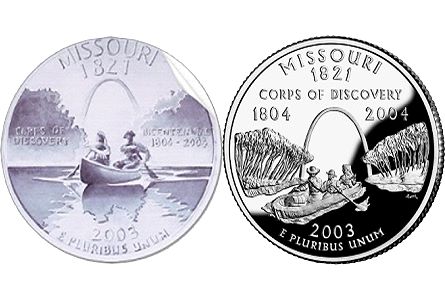
The original artwork featured Lewis & Clark (left), while the minted coin features a third man, Clark’s slave York. Original artwork by Paul Jackson, all rights reserved.
York
The first historical African-American to appear on a circulating United States coin was William Clark’s slave York. Based upon the paltry amount of information we have about him, we know that York was roughly the same age as Clark and lived with him throughout childhood. York was Clark’s “body slave” – that is, if you can imagine such a thing, a put-upon – and in the case of York, a constantly put down, personal valet. Brian Hall, who researched extensively the way York was treated by Clark and Lewis for his novel I Should Be Extremely Happy in Your Company, says Clark’s “callousness toward York sits awkwardly with his portrayal as an American hero.”[1] In fact, it is the very depiction of York rowing a canoe in the shadow of Eero Saarinen’s St. Louis Gateway Arch that is emblematic of the cruelest aspect of York’s life. After having accompanied Lewis, Clark, and their personally-selected group of adventurers and military men, York expected some consideration for his contribution to the celebrated journey. Each of the other members of the group was compensated. Lewis was given a significant political position as the second American governor of the Louisiana Territories (replacing the treasonousJames Wilkinson). Sacagawea is said to have settled with her husband Charbonneau in St. Louis (at Clark’s request), bearing a boy and a girl before dying from illness in 1812. Some oral traditions have her returning home to Shoshone country and living to the ripe old age of 96. But the freedom York sought was denied him by Clark, who ordered him to leave his wife (slave marriages not being legally binding) and come with him to St. Louis.
What happened to York after this point is anyone’s guess. The black adventurer the Arikara people dubbed “Big Medison” could have met any number of fates. Clark told Washington Irving in 1832 that he had set York free but that he had failed as a free man and was trying to make his way back to St. Louis to return to Clark’s service when he died. As with the Sacagawea story, some speculate that York made his way back out to the frontier and lived a noble life amongst the native peoples. Perhaps this myth sits well with the American soul and the mystical nature of the American frontier.
However, how York came to be included in the design is one of the great stories surrounding modern coinage.
Quartergate
When the Mint revealed the design that had been selected for the Missouri quarter, Columbia, Missouri-based watercolorist Paul Jackson was incensed. Jackson, who several months earlier had submitted the winning entry, was appalled at the artistic liberties Mint sculptors had taken with his piece. While in another high-profile contest (for the Bicentennial commemoratives) Chief Engraver Frank Gasparro made several changes to the winning designs “to better facilitate their coinage on high speed presses”[2], those artists were still credited for their designs. In this case things were different.
In Jackson’s mind, they had dumbed down his carefully considered piece of art, and worse yet, taken credit for its design. He launched a campaign at the state capital to convince Governor Bob Holden (D) and his wife Lori Hauser Holden (who publicly spearheaded the design competition), to convince the Mint to use his original design instead. When that went nowhere, he traveled to the nation’s capital to see if he could be a more visible thorn in the Mint’s side. Jackson was onto something. Several artists from other states had seen their jubilation turn to disappointment when mint sculptors altered their designs and took credit for their work. He continued to speak out and luckily for him, the media began to take notice.
Despite what Jackson believed he was signing up for when he entered the contest, the Mint was perfectly within their rights. The artwork submission guidelines stated that the Mint would produce drawings of all design concepts. Even though Jackson’s artwork was clearly an improvement over every version attempted by mint artists, the Mint was under no obligation to use any original artwork from an outside artist. Furthermore, the 50 States Commemorative Coin Program Act – Public Law 105-124 – stated that each of the 50 designs were to be selected by the Secretary of the Treasury after consultation with the Governor of the State being commemorated. This didn’t preclude the Mint from making an exception, and certainly a case can be made that if the Mint’s artists weren’t improving or finishing a design concept but merely plagiarizing a finished piece of art, then some credit on the coin should have gone to Paul Jackson. Of course, Chief Engraver Frank Gasparro shared no credit with Michael Collins, the designer of the Apollo 11 mission insignia, when he lifted it for use on the reverse of the Eisenhower and Susan B. Anthony dollars.
So how did York make it onto the coin? The answer is shrouded in mystery and involves an artist’s hurt feelings, claims of plagiarism and unfair profit-taking, all of which caused enormous embarrassment for the U.S. Mint and the State Quarter program. We reached out to Paul Jackson to ask him about his design and find out his feelings on the matter, and to find out if there were versions of his design that didinclude York. Jackson responded, saying that he had tinkered with the idea of including York on the coin, but felt that putting another person on the coin made it too crowded. So instead he put Lewis and Clark together in a canoe, a design meant to be emblematic of the Corps of Discovery’s expedition, not a factual representation of the group. He felt that Mint engraver Alfred Maletsky changed the design just enough to be able to take credit. He cites a conversation he had with a Mint official that told him that to have his initials on a circulating U.S. coin could be worth millions of dollars and that they had no interest in bestowing such an honor onto him.[3]
Whatever the Mint’s motives and whether or not you believe Jackson’s account of the meeting, [don’t want to sound too harsh but at the same time just b/c someone spoke to us is no reason to take their word over all others] it’s clear that Mint Director Ed Moy was aware of the significance of including York in the Mint’s version of the Missouri reverse. In an interview session Moy had with the media commemorating the release of the District of Columbia quarter, Moy pointed out that the D.C. quarter was the first circulating U.S. coin to have an African-American going “solo”. A CNN article quoting Moy goes on to mention the significance of the Missouri quarter further in the story.[4]
Collectability
The Missouri quarter is a common coin. The Philadelphia and Denver mints combined to produce more than 450,000,000 pieces[5] with untold millions sold to collectors in rolls and bags or pulled out of circulation in mint state bank rolls. Coin dealers will be opening government-packaged Missouri quarters for the next hundred years, so the prospects of the coin becoming a highly sought after numismatic rarity are quite remote. That said, registry set collectors looking for the coin in MS-68 have pushed the Philly release into the thousands of dollars (it’s quite elusive) and the Denver strikes go for a couple hundred when you find them[6]. NGC attributes Prooflike examples and has seen fewer than ten from both mints combined. For those who are interested in buying a superior quality version of the coin without spending real money, a nice MS-67 version in an NGC or PCGS holder can be had for about the cost of the plastic. We wouldn’t recommend spending any more than that. Proofs are abundant raw and in PR-69DCAM with the standard modern-coin marketing premium for coins holdered as PR-70DCAM.
Also of note were some 250,000 State Quarters ($62,500 worth) stickered with Paul Jackson’s original design. The Mint was so displeased when they heard that the artist had circulated his own design that U.S. Mint spokesperson Dave Hecox was said to have phoned the Associated Press to report that Jackson was under Secret Service investigation for the crime of defacing money. No such charges stemmed from the action, and in fact, when Jackson tried to turn himself in to the Secret Service, officials there were unaware of any such investigation.[7] Exonumists will probably be interested in this piece of U.S. numismatic history.
THE DUKE – ONE OF TWO AFRICAN-AMERICANS CONSIDERED…
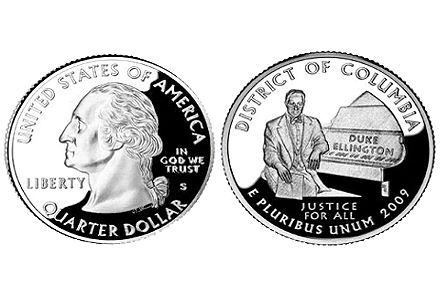
Flying “Solo” At Last
Sixty-three years after Booker T. Washington was posthumously bestowed the honor of being the first African-American to grace a United States commemorative coin, legendary Jazz musician and Washington, D.C. native son Edward Kennedy “Duke” Ellington became the first African-American featured as the sole figure on a circulating United States coin. Two additional African-American figures were considered, Maryland-born freeman Benjamin Banneker (1731-1806) and slave-turned American statesman Frederick Douglass (1818-1895).
Whereas Banneker’s contributions to the construction of the federal city are the stuff of myth and legend (he supposedly recalled L’Enfant’s city plan from memory, while others claim he wrote America’s first almanac), Douglass’s impact on American history is beyond reproach. He wrote a number of autobiographies, gained prominence as one of his era’s great orators, and stood as clear, irrefutable evidence that it was the slave’s subjugation and lack of education (it was illegal at the time to teach slaves how to read) – and not any genetic or natural disposition – that justified their lesser status as men and women.
As for Duke Ellington, the “Duke” was a pioneering figure in American music. He began performing professionally at the age of 17 and eventually assembled a band whose music transcended racial and social boundaries. Ellington recorded hundreds of songs with some of the 20th century’s most important musical figures. Ellington was honored with the Presidential Medal of Freedom in 1969 for traveling the world carrying the message of freedom through music.
The three figures were put up for a public vote, and the choice was sweet music to Washingtonians’ ears.
“Taxation without Representation”
No story involving the District of Columbia and its long-standing feud with the Federal Government would be complete without some element of intrigue. The District, which has a population comparable to states such as Alaska, North Dakota, Vermont, and over 100,000 people more than Wyoming, has bristled for years over its lack of political representation in Congress. The dispute grew more public when in 2000, the District changed its license plate design to read “No Taxation without Representation”[8] owing to the special status the District holds under Article 1, Section 8 of the United States Constitution.
Voting rights activists and civic leaders inside the District saw the commemorative quarter design as an opportunity to broaden awareness of the District’s lack of a vote in Congress. The effort to include the “No Taxation” motto was undertaken by Mayor Adrian Fenty, although it was widely supported in the District and was included in nearly one-third of the submitted ideas for the coin’s inscription, according to city officials.[9] The Mint rejected the proposal almost immediately, saying in a statement that “although the United States Mint expresses no position on the merits of this issue, we have determined that the proposed inscription is clearly controversial and, therefore, inappropriate as an element of design for United States coinage”.[10] Ultimately, the inscription “JUSTICE FOR ALL” was chosen- an odd inscription to accompany the Jazz legend, to be sure, but one that they figured would certainly offend no one.
Collectability
There were two proof versions of the District of Columbia quarter minted to go along with the business strikes. The intended for circulation business strikes were made in significant quantities. The combined 172,400,000 coins minted from Philadelphia and Denver were the most of any design minted in 2009.[11] The typical graded example of the two quarters is MS-67, with no examples grading higher.[12] As for the Satin Finish coins included in that year’s Uncirculated Mint Sets, submitted coins tend to be graded MS-68, with 15-20% grading MS-69.[13] When coins tend to come nice, such as these, we don’t see the efficacy of paying a substantial premium for a coin that’s only marginally nicer. Proofs are abundant, with most raw and graded examples being of PR-69DCAM quality, and better persevered and better struck examples holdered as PR-70DCAM. A market premium exists for PR-70DCAM coins in PCGS holders, but it’s slight.
EMBLEMATIC OF LIBERTY – HETTIE ANDERSON AND AMERICA’S MOST BEAUTIFUL COIN
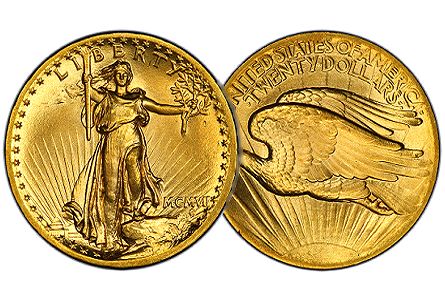
Unknown to most for many years, the famous female figure depicted as Liberty on Saint-Gaudens double eagle (1907-1932) was African-American model Hettie Anderson.
Striking Change
Were it not for trace evidence left behind in the form of sketches and personal correspondence, the true story of Augustus Saint-Gaudens and the creation of his famous double eagle might not have been told. Saint-Gaudens, as it’s been well documented, was brought in to reshape the face of American coinage at the behest of President Theodore Roosevelt. His influence was far reaching and elevated the character of American coinage, through his own work and through the work of his contemporaries and acolytes. The Saint-Gaudens double eagle stands as his signature coin. A bold design, it features a triumphant Liberty carrying the torch of freedom in one hand and an olive branch in another as she ascends to the top of a craggy hill. Resplendent rays of sunlight radiate from behind and in the distance the most famous landmarks of America’s capital city can be made out. Surrounding her are 47 stars, each one representing a state. The design was so elegant and grand that Augustus wanted the date to be depicted in Roman numerals and the relief to be so high that the coining presses of his day could barely produce it. Whatever initial resistance Saint-Gaudens got from the Mint, most notably from Chief Engraver Charles Barber and Treasury Secretary Leslie Mortier Shaw, President Roosevelt overruled it. The reverse was equally captivating. Saint-Gaudens used an Art Deco-style font reminiscent of the font John F. Flanagan would use later for the reverse of his Washington quarter. A bold eagle dominates this side, captured midflight as the sun crests on the horizon, its rays again majestic and omnipresent.
Written out of History
William E. Hagans, who spent a number of years researching the life and work of Swedish artist Anders Zorn (1860-1920), held a key piece of information that helped numismatic scholars determine just who it was that Saint-Gaudens used as a model on his famed $20 gold piece. The clue came in the form of a sketch, made extemporaneously in 1897, that shows the world-weary sculptor sitting on the edge of the model’s stand.
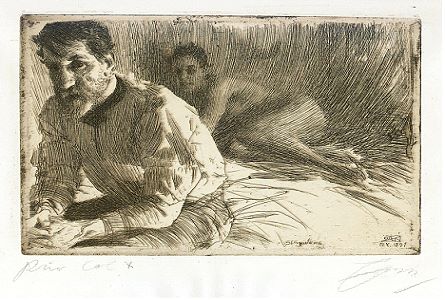 [14]
[14]
A moment in time captured by Anders Zorn: Saint-Gaudens takes a break; double eagle model Hettie Anderson, nude in the background, in repose.
In the background lies Harriette Eugenia “Hettie” Anderson, an African-American model who Saint-Gaudens referred to as a woman with the figure of a goddess.[15] It was already known that Saint-Gaudens used her as the model for the figure of Victory in his monument to Sherman. By this time, Hettie had posed for a number of artists in New York, including Saint-Gaudens’ protégé Adolph Weinman. But her connection to the double eagle was scarcely known outside of Saint-Gaudens’ closest family, friends and colleagues – and his family, at least, tried to keep it this way. Homer Saint-Gaudens, the artist’s son, edited her out of his father’s unfinished autobiography. In drawing connections to Hettie and the double eagle, Hagan solved a nearly century old mystery that was hiding in plain sight. Ten years after the Supreme Court established a Constitutional basis for separate but equal in Plessy v. Ferguson and two years before the National Negro Committee convenes (leading to the founding of the NAACP), Hettie Anderson, an African-American model from South Carolina, became the iconic symbol of Liberty on America’s most enduring coin. A design that prompted President Theodore Roosevelt to write that Saint-Gaudens’ double eagle “is the best coin that has been struck for two thousand years… [a coin that] will serve as a model for future coin makers….”[16]
WHAT COULD HAVE BEEN? MARTIN LUTHER KING, JR., HARRIET TUBMAN AND BESSIE COLEMAN CONSIDERED FOR GOLDEN DOLLAR COIN.
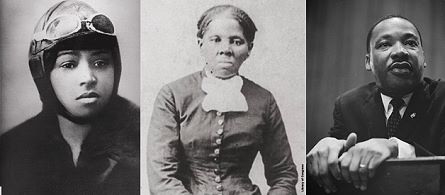 [17]
[17]
(L to R) Bessie Coleman, Harriet Tubman, and Martin Luther King, Jr.
The rebirth of the dollar coin was a long time coming. Even though the Susan B. Anthony dollar program was stillborn, some members of Congress were convinced that a publicly-accepted dollar coin was possible, if certain changes were made to its design and composition. The idea for a golden dollar coin dates back to before the release of the Susan B. Anthony dollar in 1979, but it took nearly eighteen years before the program became a reality.
During the design process, a Colorado-based graphic artist named Daniel Carr submitted a few of his design proposals, including one which featured a portrait of early 20th century African-American aviatrix Bessie Coleman. Coleman was a high-flying stunt pilot who barnstormed across the United States performing daring tricks in front of paying audiences – that is, until a maintenance oversight on the part of her mechanic and agent, William Wills, caused her Curtiss JN-4 biplane to lose control, hurtling Coleman 2,000 feet to the ground without a parachute and sending Wills and the plane plummeting to the ground. Carr’s Coleman design received national attention when a large mock-up was featured in a June 9, 1998 Washington Post article by Bill McAllister covering the Treasury Department advisory committee meetings on which design would grace the 2000 golden dollar.
It was during these hearings that abolitionist Harriet Tubman was considered as a potential sidekick for a revised Susan B. Anthony dollar (which presumably would feature portraits of the two suffragettes in jugate). The colossal failure of the Susan B. Anthony dollar program still fresh in the minds of the design board made the idea of retaining any connection to that coin untenable. Furthermore, some, including Delaware Senator Mike Castle (R) blamed the failure of the dollar program on the fact that Susan B. Anthony “remains an obscure historical figure to most citizens in spite of being the most politically correct choice at the time”[18]
After a few rounds of voting, Lewis and Clark Shoshone Indian guide Sacagawea was chosen to grace the first new coin of the 21st century. Daniel Carr’s Bessie Coleman proposal and the proposal to add Harriet Tubman were relegated to historical footnotes.
Interestingly, it was three years after the release of the Sacagawea dollar that New York Representative Charlie Rangel (D) proposed to change the design to feature slain Civil Rights leader Martin Luther King, Jr. Rangel, seizing upon the perceived failure of the Sacagawea dollar program, saw an opening to promote an important African-American national figure.
The Act, known as the Dr. Martin Luther King, Jr., 1 Dollar Coin Act, cited King’s numerous accomplishments as a proponent for peace, social reform, and non-violent activism, and called for a new dollar coin that featured a likeness of King on the obverse and a reverse emblematic of King’s philosophy.[19] The bill was tabled in committee (along with another Rangel proposal that called for a commemorative dollar honoring Thurgood Marshall).
Rangel had a point in nominating King for the coin. Martin Luther King, Jr. is certainly one of the most crucial figures in modern American history and is better known to contemporary Americans than a member of Lewis & Clark’s expedition. It’s also simply amazing that King has never been honored on a United States commemorative coin – and only time will tell if this criminal omission isn’t rectified with the forthcoming Civil Rights Act Commemorative dollar slated for a 2014 release.
The Future
What lies ahead for United States coinage is anybody’s guess. It seems likely that we’ll see the elimination of familiar denominations before we see wholesale changes of the people on our circulating coins. The Lincoln cent is one of the hobby’s most collected designs and has been in production for more than a hundred years. The Mint did toy with a total redesign of the coin in the mid-1950s, but nothing came of it. Jefferson has owned the nickel since 1938 and only recently underwent a design overhaul. Roosevelt and Kennedy were memorialized on the dime and half dollar shortly after their deaths, and it’s hard to imagine any of these important historical figures being evicted from their spots on U.S. coinage in favor of someone new. A much more likely scenario is that lesser denominations will be discontinued due to their increasingly low purchasing power.
With the negative seigniorage that the nickel and cent are experiencing, it’s only a matter of time before either 1) a new composition is introduced, or 2) the coins are phased out. In the event that this does happen, a call will be made to introduce new, usable coinage. When that time comes a choice will have to be made as to who is represented on these new coins. We hope that Americans will rightly consider the contributions of those important figures not yet memorialized on our money. In England, the obverse of their national coinage bears the image of kings and queens. In America, it’s high time that a certain King gets his due.
Flip of a Coin
The Philadelphia Mint reopened its doors to the public starting July 3, 2012 (the tour was closed for renovations). This self-guided tour allows visitors a “bird’s eye” view of the factory floor. It includes an exhibit on the nation’s first coining press, as well as artifacts and artwork from over 220 years of mint history. Oh, and lest we forget, Peter the Mint Eagle is still there.
With all the talk lately about the demise of the Euro (premature, we assume), let’s not forget an earlier attempt at continental currency: the Latin Monetary Union. The LMU was founded in 1865 and sought to standardize international coinage in order to facilitate trade. The U.S. even explored the possibility of entering into the union by designing a curious $4 coin known as the Stella. Ultimately, the LMU collapsed, in no small part due to a currency debasement scheme perpetrated by the (wait for it) Greek government.
In Memorial: Aaron Miller (1979-2012). It was a sad day when the Ike Group found out that it had lost a good friend and collaborator in Aaron Miller. Aaron passed away at the age of 32 after a brief illness. Aaron was deeply interested in the study of Eisenhower dollars and even brought his fiancé along with him to Rob Ezerman’s three hour-long Ike Workshop at the 2008 ANA show in Baltimore. One of Aaron’s most interesting finds, a beautiful MS-66 1971-D Friendly Eagle type Eisenhower dollar with dramatic doubling on the reverse has challenged the Ike Group and Eisenhower dollar doubled die experts John Wexler and Tom Kalantzis for years. Aaron is survived by his wife Amanda and his daughter Lauren.
Charles Morgan is a member of the Ike Group and is working with Rob Ezerman on GradeView™: Eisenhower Dollars and with longtime collaborator Hubert Walker on a number of other projects, including the Registry Set Collector’s Guide to US Coinage, which will be published sometime next year.
Hubert Walker’s background is in the classics. A nationally-recognized Latin scholar when younger, Hubert’s interest in history and symbology connects him to modern coins as well as ancients. He also likes the movies, among other things.
Charles and Hubert’s informative columns appear weekly at CoinWeek.com.
[1] Hall, Brian. “The Slave Who Went with Them”. Time Magazine. 8 July 2002.
[2] Slabaugh, Arlie R. United States Commemorative Coinage: The Drama of America As Told By Our Coins, Second Edition. Whitman Publishing Co.,1975. Print.
[3] http://www.pauljackson.com/Quartergate.pdf. Accessed 7/9/2012
[4] “Jazz man is first African-American to solo on U.S. circulating coin” CNN.com. 24 February, 2009. Accessed 7/9/2012
[5] Yeoman, R. S. A Guide Book of United States Coins 2013. Atlanta: Whitman. 2013. Print.
[6] www.pcgs.com auction history. Accessed 7/9/2012
[7] http://www.pauljackson.com/Quartergate.pdf. Accessed 7/9/2012
[8] http://voices.washingtonpost.com/rawfisher/2008/02/what_wont_be_on_the_dc_quarter.html
[9] Sheridan, Mary Beth. “Mint Expected to Balk at Voting Rights Message.” Washington Post. 26 February, 2008.
[10] “U.S. Mint Rejects D.C. Quarter Design Inscription, ‘Taxation Without Representation’”Coinnews.net. 27 February 2008. Accessed 7/11/2012.
[11] Yeoman, R. S. A Guide Book of United States Coins 2013. Atlanta: Whitman. 2013. Print.
[12] Population totals from pcgs.com. Accessed 7/12/2012.
[13] Ibid.
[14]http://upload.wikimedia.org/wikipedia/commons/1/1b/Anders_Zorn_Augustus_Saint_Gaudens_II_1897.jpg
[15] Nichols, Rose Standish. “Familiar Letters of Augustus Saint-Gaudens,” McClure’s Magazine 31, no. 6 October 1908: 603-616.
[16] Taxay, Don. The U.S. Mint and Coinage. New York: Sanford J. Durst Numismatic Publications. 1966. Print.
[17] Images pulled from: http://en.wikipedia.org/wiki/File:Martin-Luther-King-1964-leaning-on-a-lectern.jpg,http://iipdigital.usembassy.gov/st/english/inbrief/2012/01/201201300779.html#axzz1yo14Becb, and http://en.wikipedia.org/wiki/Bessie_Coleman
[18] McAllister, Bill. “Few Votes for Suffragette: Susan B. Anthony Garners Little Support As Panel Ponders New Design for Dollar Coin” Washington Post. 9 June, 1998.
[19] http://thomas.loc.gov/cgi-bin/query/z?c108:H.R.1016:
(c) 2012 Charles Morgan and Hubert Walker and This article originally appeared at www.coinweek.com.

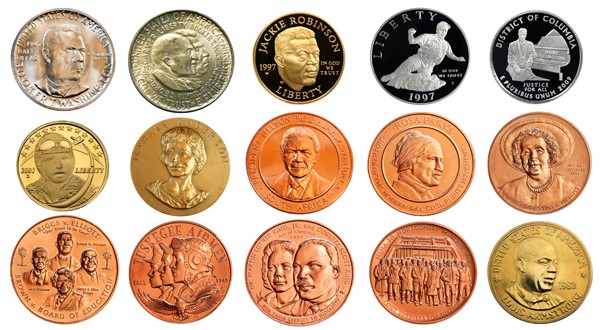
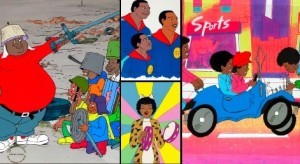

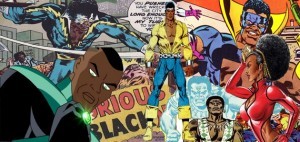

0 Comments